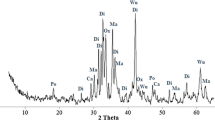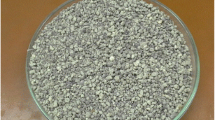Abstract
Mineral carbonation of serpentinite mining residue offers an environmentally secure and permanent storage of carbon dioxide. The strategy of using readily available mining residue for the direct treatment of flue gas could improve the energy demand and economics of CO2 sequestration by avoiding the mineral extraction and separate CO2 capture steps. The present is a laboratory scale study to assess the possibility of CO2 fixation in serpentinite mining residues via direct gas–solid reaction. The degree of carbonation is measured both in the absence and presence of water vapor in a batch reactor. The gas used is a simulated gas mixture reproducing an average cement flue gas CO2 composition of 18 vol.% CO2. The reaction parameters considered are temperature, total gas pressure, time, and concentration of water vapor. In the absence of water vapor, the gas–solid carbonation of serpentinite mining residues is negligible, but the residues removed CO2 from the feed gas possibly due to reversible adsorption. The presence of small amount of water vapor enhances the gas–solid carbonation, but the measured rates are too low for practical application. The maximum CO2 fixation obtained is 0.07 g CO2 when reacting 1 g of residue at 200 °C and 25 barg (pCO2 ≈ 4.7) in a gas mixture containing 18 vol.% CO2 and 10 vol.% water vapor in 1 h. The fixation is likely surface limited and restricted due to poor gas–solid interaction. It was identified that both the relative humidity and carbon dioxide-water vapor ratio have a role in CO2 fixation regardless of the percentage of water vapor.







Similar content being viewed by others
References
Auroux A, Gervasini A (1990) Microcalorimetric study of the acidity and basicity of metal oxide surfaces. J Phys Chem 94:6371–6379
Béarat H, McKelvy MJ, Chizmeshya AV, Gormley D, Nunez R, Carpenter R, Squires K, Wolf GH (2006) Carbon sequestration via aqueous olivine mineral carbonation: role of passivating layer formation. Environ Sci Technol 40:4802–4808
Beaudoin G, Hébert R, Constantin M, Duchesne J, Cecchi E, Huot F, Vigneau S, Fiola R (2008) Spontaneous carbonation of serpentine in milling and mining waste, southern Québec and Italy. Proceedings of accelerated carbonation for environmental and materials engineering (ACEME 2008), pp. 73–82
Beruto DT, Botter R (2000) Liquid-like H2O adsorption layers to catalyze the Ca(OH)2/CO2 solid-gas reaction and to form a non-protective solid product layer at 20 °C. J Eur Ceram Soc 20:497–503
Bonenfant D, Kharoune L, Sauvé S, Hausler R, Niquette P, Mimeault M, Kharoune M (2009) Molecular analysis of carbon dioxide adsorption processes on steel slag oxides. Int J Greenhouse Gas Control 3:20–28
Cavenati S, Grande CA, Rodrigues AE (2004) Adsorption equilibrium of methane, carbon dioxide, and nitrogen on zeolite 13X at high pressures. J Chem Eng Data 49:1095–1101
Da Costa HF, Fan M, Russell AT (2010) Method to sequester CO2 as mineral carbonate. U.S. Patent U.S. Patent 0221163A1
Daldoul I (2009) Caractérisation et étude de la performance du chrysotile dans la capture du dioxyde de carbone dans les procédés gaz-solide. PhD dissertation, Université Laval
Drever JI (1985) The chemistry of weathering. Springer, Dordrecht
Fagerlund J, Teir S, Nduagu E, Zevenhoven R (2009) Carbonation of magnesium silicate mineral using a pressurised gas/solid process. Energy Procedia 1:4907–4914
Fagerlund J, Nduagu E, Romão I, Zevenhoven R (2010) A stepwise process for carbon dioxide sequestration using magnesium silicates. Front Chem Eng Chin 4:133–141
Fagerlund J, Nduagu E, Zevenhoven R (2011) Recent developments in the carbonation of serpentinite derived Mg(OH)2 using a pressurized fluidized bed. Energy Procedia 4:4993–5000
Fagerlund J, Highfield J, Zevenhoven R (2012a) Kinetics studies on wet and dry gas–solid carbonation of MgO and Mg(OH)2 for CO2 sequestration. RSC Adv 2:10380–10393
Fagerlund J, Nduagu E, Romão I, Zevenhoven R (2012b) CO2 fixation using magnesium silicate minerals part 1: process description and performance. Energy 41:184–191
Fisher LW (1929) Origin of chromite deposits. Econ Geol 24:691–721
Fricker KJ, Park AHA (2013) Effect of H2O on Mg(OH)2 carbonation pathways for combined CO2 capture and storage. Chem Eng Sci 100:332–341
Gravel JP (2011) Activation des silicates magnésiens pour la capture du CO2 à haute pression: application aux effluents de précombustion. PhD dissertation, Université Laval
Hänchen M, Prigiobbe V, Storti G, Seward TM, Mazzotti M (2006) Dissolution kinetics of fosteritic olivine at 90–150 °C including effects of the presence of CO2. Geochim Cosmochim Acta 70(17):4403–4416
Herzog H (2002) Carbon sequestration via mineral carbonation: overview and assessment. MIT Laboratory for Energy and the Environment, MIT (MA), Massachusetts
Highfield J, Chen J, Bu J, Abacka J, Fagerlund J, Zevenhoven R (2013) Steam-promoted gas-solid carbonation of magnesia and brucite below 200 °C. In: Rabab N, Rafael S, özlem C, Tom VG (eds) Proceeding of 4th international conference on acceleiated carbonation for environmental and materials engineering. ACEME 2013. Leuven, Belgium
Huijgen W (2007) Carbon dioxide sequestration by mineral carbonation: feasibility of enhanced natural weathering as a CO2 emission reduction technology. Ph. D. thesis, energy research center of the Netherlands: Enschede, Gildeprint BV
Huijgen WJJ, Comans RNJ (2003) Carbon dioxide sequestration by mineral carbonation: literature review. Energy research centre of the Netherlands ECN
Huijgen WJJ, Comans RNJ (2005) Carbon dioxide sequestration by mineral carbonation: literature review update 2003–2004, energy research centre of The Netherlands, Petten, The Netherlands, ECN-C--05-022
IPCC (2005) In: Metz B, Davidson O, De Coninck HC, Loos M, Meyer LA (eds) IPCC special report on carbon dioxide capture and storage: prepared by working group III of the intergovernmental panel on climate change. IPCC, Cambridge University Press, Cambridge
IPCC (2007) Synthesis report, contribution of working groups I, II and III to the fourth assessment. IPCC, Geneva
Jolicoeur C, Duchesne D (1981) Infrared and thermogravimetric studies of the thermal degradation of chrysotile asbestos fibres: evidence for matrix effects. Can J Chem 59:1521–1526
Kharecha PA, Hansen JE (2008) Implications of “peak oil” for atmospheric CO2 and climate. Glob Biogeochem Cycles 22
Kirchofer A, Brandt A, Krevor S, Prigiobbe V, Wilcox J (2012) Impact of alkalinity sources on the life-cycle energy efficiency of mineral carbonation technologies. Energy Environ Sci 5:8631–8641
Kwon S (2011) Mineralization for CO2 sequestration using olivine sorbent in the presence of water vapor. PhD dissertation, Georgia Institute of Technology
Kwon S, Fan M, DaCosta HF, Russell AG (2011) Factors affecting the direct mineralization of CO2 with olivine. J Environ Sci 23:1233–1239
Lackner KS, Wendt CH, Butt DP, Joyce BL, Sharp DH (1995) Carbon dioxide disposal in carbonate minerals. Energy 20(11):1153–1170
Lackner KS, Butt DP, Wendt CH (1997) Progress on binding CO2 in mineral substrates. Energy Convers Manag 38:S259–S264
Larachi F, Daldoul I, Beaudoin G (2010) Fixation of CO2 by chrysotile in low-pressure dry and moist carbonation: Ex-situ and in-situ characterizations. Geochim Cosmochim Acta 74:3051–3075
Larachi F, Gravel JP, Grandjean BPA, Beaudoin G (2012) Role of steam, hydrogen and pretreatment in Chrysotile gas–solid carbonation: opportunities for pre-combustion CO2 capture. Int J Greenhouse Gas Control 6:69–76
Laurent R (1975) Occurrences and origin of the ophiolites of southern Quebec, northern Appalachians. Can J Earth Sci 12:443–455
Lee KM, Lim YH, Jo YM (2012) Evaluation of moisture effect on low-level CO2 adsorption by ion-exchanged zeolite. Environ Technol 33:77–84
Manovic V, Anthony EJ (2010) Carbonation of CaO-based sorbents enhanced by steam addition. Ind Eng Chem Res 49:9105–9110
Maroto-Valer M, Fauth D, Kuchta M, Zhang Y, Andresen J (2005) Activation of magnesium rich minerals as carbonation feedstock materials for CO2 sequestration. Fuel Process Technol 86:1627–1645
McKelvy MJ, Chizmeshya AVG, Diefenbacher J, Béarat H, Wolf G (2004) Exploration of the role of heat activation in enhancing serpentine carbon sequestration reactions. Environ Sci Technol 38:6897–6903
MDDEFP (2013) Inventaire québécois des émissions de gaz à effet de serre en 2010 et leur évolution depuis 1990, Québec, Ministère du développement durable de l’environnement de la faune et des parcs direction des politiques de la qualité de l’atmosphère, p. 20
Murphy WJ, Ross RA (1977) A comparative study of thermal effects on surface and structural parameters of natural Californian and Quebec chrysotile asbestos up to 700 °C. Clay Clay Miner 25:78–89
Nduagu E, Bergerson J, Zevenhoven R (2012a) Life cycle assessment of CO2 sequestration in magnesium silicate rock—a comparative study. Energy Convers Manag 55:116–126
Nduagu E, Björklöf T, Fagerlund J, Mäkilä E, Salonen J, Geerlings H, Zevenhoven R (2012b) Production of magnesium hydroxide from magnesium silicate for the purpose of CO2 mineralization—part 2: Mg extraction modeling and application to different Mg silicate rocks. Miner Eng 30:87–94
Nduagu E, Björklöf T, Fagerlund J, Wärnå J, Geerlings H, Zevenhoven R (2012c) Production of magnesium hydroxide from magnesium silicate for the purpose of CO2 mineralisation—part 1: application to Finnish serpentinite. Miner Eng 30:75–86
Nikulshina V, Gálvez ME, Steinfeld A (2007) Kinetic analysis of the carbonation reactions for the capture of CO2 from air via the Ca(OH)2–CaCO3–CaO solar thermochemical cycle. Chem Eng J 129:75–83
NOAA (2013) The most recent preliminary estimate of global monthly mean CO2 concentration (as of May 2014) is 401.85 ppm: (Dr. Pieter Tans, NOAA/ESRL(http://www.esrl.noaa.gov/gmd/ccgg/trends/) and Dr. Ralph Keeling, Scripps Institution of Oceanography (scrippsco2 .ucsd.edu/))
O’Connor WK, Dahlin DC, Nilsen DN, Walters RP, Turner PC (2000) Carbon dioxide sequestration by direct mineral carbonation with carbonic acid, proceedings, 25th international technical conference on coal utilization and fuel systems. Clearwater, Florida
O’Connor WK, et al (2005) Aqueous mineral carbonation, final report, Albany research center (ARC), Albany, OR: 21
Pacchioni G, Ricart JM, Illas F (1994) Ab initio cluster model calculations on the chemisorption of CO2 and SO2 probe molecules on MgO and CaO (100) surfaces. A theoretical measure of oxide basicity. J Am Chem Soc 116:10152–10158
Perry’s R, Chilton C, Kirkpatrick S (1999) Chemical engineers handbook
Pronost J, Beaudoin G, Tremblay J, Larachi F, Duchesne J, Hébert R, Constantin M (2011) Carbon sequestration kinetic and storage capacity of ultramafic mining waste. Environ Sci Technol 45:9413–9420
Seifritz W (1990) CO2 disposal by means of silicates. Nature 345:486–486
Sipilä J, Teir S, Zevenhoven R (2008) Carbon dioxide sequestration by mineral carbonation Literature review update 2005–2007, Åbo Akademi Univ. Heat Eng Lab. report VT
Torróntegui MD (2010) Assessing the mineral carbonation science and technology. MSc. Thesis, Swiss Federal Institute of Technology, Zürich, Switzerland
USGS, 1901. American Chrome: Minor pediform chromite deposit in Canada by U.S. geological survey: http://mrdata.usgs.gov/podchrome/show-podchrome.php?rec_id=530
Webmineral (1990) Lizardite, http://webmineral.com/data/Lizardite.shtml#.UvmD_vldU3A Accessed on February 10, 2014
Wilcox J (2012) Carbon capture. Springer US, Boston, MA. http://edepot.wur.nl/208032 Accessed on 12 Jan. 2013
Wilson SA, Dipple GM, Power IM, Thom JM, Anderson RG, Raudsepp M, Gabites JE, Southam G (2009) Carbon dioxide fixation within mine wastes of ultramafic-hosted ore deposits: examples from the Clinton creek and cassiar chrysotile deposits, Canada. Econ Geol 104:95–112
Wilson SA, Dipple GM, Power IM, Barker SLL, Fallon SJ, Southam G (2011) Subarctic weathering of mineral wastes provides a sink for atmospheric CO2. Environ Sci Technol 45:7727–7736
Zevenhoven R, Fagerlund J (2011) Mineral sequestration for CCS in Finland and abroad, World Renewable Energy Conference 8–13 May 2011. Clim Chang Issues 2:660, Sweden
Zevenhoven R, Kohlmann J, Mukherjee BA (2002) Direct dry mineral carbonation for CO2 emissions reduction in Finland, 27th international technical conference on coal utilization & fuel systems clearwater (FL), USA
Zevenhoven R, Teir S, Eloneva S (2008) Heat optimisation of a staged gas–solid mineral carbonation process for long-term CO2 storage. Energy 33:362–370
Zevenhoven R, Fagerlund J, Nduagu E, Romão I, Jie B, Highfield J (2013) Carbon storage by mineralisation (CSM): serpentinite rock carbonation via Mg(OH)2 reaction intermediate without co2 pre-separation. Energy Procedia 37:5945–5954
Acknowledgments
The authors would like to thank INRS-ETE, Québec, FQRNT, NSERC CRSNG, Carbon Management Canada, and Sigma Devtec for the funding and support for this project. The authors would also like to thank the department of Chemical and Biomolecular Engineering of The University of Melbourne, Australia, for providing moral and lab support for the fulfillment of this work.
Author information
Authors and Affiliations
Corresponding author
Additional information
Responsible editor: Bingcai Pan
Rights and permissions
About this article
Cite this article
Veetil, S.P., Pasquier, LC., Blais, JF. et al. Direct gas–solid carbonation of serpentinite residues in the absence and presence of water vapor: a feasibility study for carbon dioxide sequestration. Environ Sci Pollut Res 22, 13486–13495 (2015). https://doi.org/10.1007/s11356-015-4580-x
Received:
Accepted:
Published:
Issue Date:
DOI: https://doi.org/10.1007/s11356-015-4580-x




